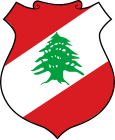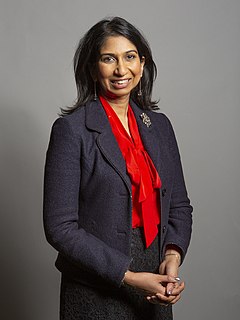 |
|---|
|
A transitional military cabinet was formed on 22 September 1988, the last day of Amine Gemayel presidency, dismissing the current cabinet headed by Salim Hoss. The Prime Minister was General Michel Aoun, the commander of the army at the time. [1]
 |
|---|
|
A transitional military cabinet was formed on 22 September 1988, the last day of Amine Gemayel presidency, dismissing the current cabinet headed by Salim Hoss. The Prime Minister was General Michel Aoun, the commander of the army at the time. [1]
| Military Cabinet of Michel Aoun | ||||
|---|---|---|---|---|
| Portfolio | Minister | Political affiliation | Religious affiliation | Governorate |
| Prime Minister | Michel Aoun | Military | Maronite | Mount Lebanon |
| Defence | ||||
| Information | ||||
| Deputy Prime Minister | Issam Abu Jamra | Military | Greek Orthodox | South |
| Telecommunications | ||||
| Housing | ||||
| Economy | ||||
| Finance | Edgar Maalouf | Military | Greek Catholic | Mount Lebanon |
| Social Affairs | ||||
| Health | ||||
| Industry | ||||
| Foreign Affairs | Muhamad Quraytem | | | |
| Education | ||||
| Interior | ||||
| Energy and Water | Lotfi Jaber | | | |
| Agriculture | ||||
| Justice | ||||
| Public Works | Mahmoud Abu Dargham | | | |
| Labour | ||||
| Tourism | ||||

A prime minister,premier or chief of cabinet is the head of the cabinet and the leader of the ministers in the executive branch of government, often in a parliamentary or semi-presidential system. Under those systems, a prime minister is not the head of state, but rather the head of government, serving under either a monarch in a democratic constitutional monarchy or under a president in a republican form of government.

The prime minister of Australia is the head of government of the Commonwealth of Australia. The prime minister heads the executive branch of the federal government of Australia and is also accountable to federal parliament under the principles of responsible government. Anthony Albanese of the Labor Party became prime minister on 23 May 2022.

The prime minister of the United Kingdom is the head of government of the United Kingdom. The prime minister advises the sovereign on the exercise of much of the royal prerogative, chairs the Cabinet and selects its ministers. As modern prime ministers hold office by virtue of their ability to command the confidence of the House of Commons, they sit as members of Parliament.

The prime minister of India is the head of government of the Republic of India. Executive authority is vested in the prime minister and their chosen Council of Ministers, though the President of India is the constitutional, nominal, and ceremonial head of state. The prime minister is often the leader of the party or the coalition with a majority in the lower house of the Parliament of India, the Lok Sabha, which is the main legislative body in the Republic of India. The prime minister and their cabinet are at all times responsible to the Lok Sabha.

The prime minister of Japan is the head of government of Japan. The prime minister chairs the Cabinet of Japan and has the ability to select and dismiss its Ministers of State. The prime minister also serves as the civilian commander-in-chief of the Japan Self Defence Forces and as a sitting member of the House of Representatives. The individual is appointed by the emperor of Japan after being nominated by the National Diet and must retain the nomination of the lower house and answer to parliament to remain in office.

The Cabinet of the United States is a body consisting of the vice president of the United States and the heads of the executive branch's departments in the federal government of the United States. It is the principal official advisory body to the president of the United States. The president chairs the meetings but is not formally a member of the Cabinet. The heads of departments, appointed by the president and confirmed by the Senate, are members of the Cabinet, and acting department heads also participate in Cabinet meetings whether or not they have been officially nominated for Senate confirmation. The president may designate heads of other agencies and non-Senate-confirmed members of the Executive Office of the President as members of the Cabinet.

The secretary of state for the Home Department, otherwise known as the home secretary, is a senior minister of the Crown in the Government of the United Kingdom. The home secretary leads the Home Office, and is responsible for all national security, policing and immigration policies of the United Kingdom. As a Great Office of State, the home secretary is one of the most senior and influential ministers in the government. The incumbent is a statutory member of the British Cabinet and National Security Council. The post holder is fifth in the ministerial ranking.

The Cabinet of the United Kingdom is the senior decision making body of the Government of the United Kingdom. A committee of the Privy Council, it is chaired by the prime minister and its members include secretaries of state and other senior ministers.
The shadow cabinet or shadow ministry is a feature of the Westminster system of government. It consists of a senior group of opposition spokespeople who, under the leadership of the Leader of the Opposition, form an alternative cabinet to that of the government, and whose members shadow or mirror the positions of each individual member of the Cabinet. Their areas of responsibility, in parallel with the ruling party's ministries, may be referred to as a shadow portfolio. Members of a shadow cabinet have no executive power. It is the shadow cabinet's responsibility to scrutinise the policies and actions of the government, as well as to offer alternative policies. The shadow cabinet makes up the majority of the Official Opposition frontbench, as part of frontbenchers to the parliament.

The chancellor of the Duchy of Lancaster is a ministerial office in the Government of the United Kingdom. The position is currently the second highest ranking minister in the Cabinet Office, immediately after the Prime Minister, and senior to the Minister for the Cabinet Office. The role includes as part of its duties the administration of the estates and rents of the Duchy of Lancaster.

The Cabinet Office is a department of the Government of the United Kingdom responsible for supporting the prime minister and Cabinet of the United Kingdom. It is composed of various units that support Cabinet committees and which co-ordinate the delivery of government objectives via other departments. As of December 2021, it has over 10,200 staff, most of whom are civil servants, some of whom work in Whitehall. Staff working in the Prime Minister's Office are part of the Cabinet Office.
A minister without portfolio is either a government minister with no specific responsibilities or a minister who does not head a particular ministry. The sinecure is particularly common in countries ruled by coalition governments and a cabinet with decision-making authority wherein a minister without portfolio, while they may not head any particular office or ministry, may still receive a ministerial salary and has the right to cast a vote in cabinet decisions. In some countries where the executive branch is not composed of a coalition of parties and, more often, in countries with purely presidential systems of government, such as the United States, the position of minister without portfolio is uncommon.

The Government of India, or simply the Centre, is the national administrative authority of the Republic of India, a federal democracy located in South Asia, consisting of 28 union states and eight union territories. Under the Constitution, there are three primary branches of government: the legislative (Parliament), the executive and the judiciary. The president of the republic is the nominal head of the executive branch however the prime minister is the de facto chief executive.
A minister is a politician who heads a ministry, making and implementing decisions on policies in conjunction with the other ministers. In some jurisdictions the head of government is also a minister and is designated the ‘prime minister’, ‘premier’, ‘chief minister’, ‘chancellor’ or other title.
The Union Council of Ministers is the highest executive body of the Government of India. The council is responsible for exercising administrative authority in the nation and advising the president of India. It is chaired by the prime minister and consists of the heads of each of the executive government ministries. Currently, the council is headed by prime minister Narendra Modi and consists of 31 members, including the prime minister. The council is subject to the Parliament of India.

The Cabinet Secretary is the top-most executive official and senior-most civil servant of the Government of India. The Cabinet Secretary is the ex-officio head of the Civil Services Board, the Cabinet Secretariat, the Indian Administrative Service (IAS), and all Civil Services of India work under the rules of business of the government.

A cabinet is a body of high-ranking state officials, typically consisting of the executive branch's top leaders. Members of a cabinet are usually called cabinet ministers or secretaries. The function of a cabinet varies: in some countries, it is a collegiate decision-making body with collective responsibility, while in others it may function either as a purely advisory body or an assisting institution to a decision-making head of state or head of government. Cabinets are typically the body responsible for the day-to-day management of the government and response to sudden events, whereas the legislative and judicial branches work in a measured pace, in sessions according to lengthy procedures.

A cabinet is a case or cupboard with shelves and/or drawers for storing or displaying items. Some cabinets are stand alone while others are built in to a wall or are attached to it like a medicine cabinet. Cabinets are typically made of wood, coated steel, or synthetic materials. Commercial grade cabinets usually have a melamine-particleboard substrate and are covered in a high pressure decorative laminate, commonly referred to as Wilsonart or Formica.

The second Johnson ministry began on 16 December 2019, three days after Boris Johnson's audience with Queen Elizabeth II where she invited him to form a new administration following the 2019 general election, in which the Conservative Party was returned to power with a majority of 80 seats in the House of Commons. Initially the ministers were largely identical to those at the end of the first Johnson ministry, but changed significantly in cabinet reshuffles in February 2020 and September 2021.

Liz Truss was invited by Queen Elizabeth II – two days before the monarch's death – to replace Boris Johnson as prime minister of the United Kingdom on 6 September 2022. Johnson had resigned as the leader of the Conservative Party on 7 July 2022 and resigned as prime minister on 6 September 2022 following the election of Truss as the new leader of the Conservative Party on 5 September 2022. The Truss ministry was formed from the 2019 Parliament of the United Kingdom, as a Conservative majority government. With Queen Elizabeth's death on 8 September 2022, Truss became the first prime minister to serve under more than one monarch since Winston Churchill in 1952.